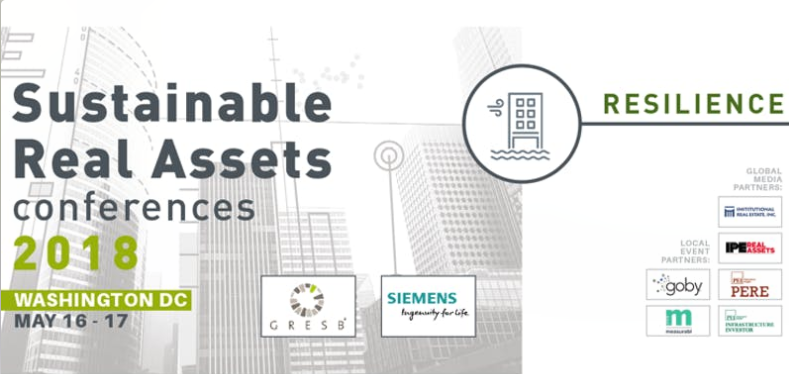
Over the last several years, resilience has emerged a material issue for GRESB investor members and participating companies and funds. Influential recommendations from the Taskforce for Climate-Related Financial Disclosures (TCFD) have increased awareness about resilience among investors and provided a framework for systematic engagement with investments. Simultaneously, property and infrastructure companies have recognized new challenges and begun to take action to mitigate risks and, in some cases, realize new business opportunities.
Both investor demand and on-the-ground action were shared during GRESB’s Sustainable Real Asset Conference in Washington, DC on May 17th. The event was hosted by MetLife in its new penthouse space at District Center. With the Washington Monument in the background and participants enjoyed a day long deep dive into resilience.
I wanted to recap three recurring themes heard during the day:
1. Awareness
Stakeholders in the real asset investment community are rapidly becoming aware of the implications of shocks and stressors for their businesses. This reflects historic weather-related losses in 2017 and new tools to understand site-specific hazards. Stephen Scofield presented a map of TCFD adoption in financial markets, convincingly illustrating growth of interest in these concepts around the world. This was supported by remarks from Amanda Wallace (J.P. Morgan Asset Management), Nina James (Investa Office Management) and Rael McNally (Blackrock) describing how resilience factors into their investment strategies, including due diligence and engagement.
2. Value at risk
New information about potential hazards may change assumptions regarding risk-adjusted returns. Keynote speaker Emilie Mazzacurati described the potential for this to result in local “valuation bubbles” where assets are mispriced relative to future risks. New data will make these bubbles visible and actionable by investors. This was echoed by Laura Craft from Heitman with reference to potential changes in demographic and economic growth scenarios from extreme events that dislocate people and cause long-term damage to housing and infrastructure. Again, these changes undermine investment assumptions and jeopardize expected returns.
3. Value creation
Fortunately, the conversation was broader and more optimistic than just managing risk. This was epitomized by Ben Myers’ presentation. He described how Boston Properties has begun to make resilience a selling point for its properties with information about backup power supplies, flood protection, and more. This illustrates leading companies can turn the challenge of resilience into an opportunity for competitive differentiation and growth. These themes were also echoed in remarks from Jamie Statter (USGBC/PEER), Greg Simmon (Siemens), and Brian Asparro (Demand Energy Networks). They all emphasized how resilience energy supply systems, including microgrids, can improve net operating income and reduce the risk of business disruption.
At the end of the day, many appreciated the deep dive into multiple aspects of resilience. However, it is important emphasize that this was not an academic conversation. There is broad-based recognition that value is risk, and there are new opportunities for value creation. Moreover, there are practical ways that GRESB stakeholders can take action today, including:
- Engaged investment: Investors can ask their investments if they are planning to respond to the new Resilience Module and prepare to engage around the results.
- Peer benchmarking: Participating companies and funds can check out the Resilience Module and consider participating. In return, participants will receive feedback about where they stand relative to their peers around the world. We can all look forward to first year results in September.
- Education and events: Finally, if you missed the GRESB program in DC, perhaps you can join us in Sydney for the third and final Sustainable Real Asset Conference of 2018. Learn more and register https://www.gresb.com/srac-sydney/
Learn more in GRESB.com and get involved today.
This article is written by Chris Pyke, Research Officer, U.S. Green Building Council.


